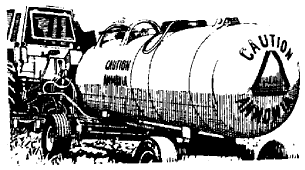Spending
a few minutes to inspect anhydrous ammonia equipment before
taking it from the dealer may help reduce problems or accidents
that can cause delays or injure the operator. Follow this
checklist to minimize the risks associated with anhydrous
applications.

- Are
the fittings and valves clean and free from rust and wear?
- Is
the kingpin in good condition and well lubricated?
- Is
the high-pressure hose secure, with no cracks or signs of
wear? Replace the hose if you can see the braided layer.
- Is
the hose free of cuts, soft spots, blistering, kinking,
flattening, or indications that it may have been stretched?
Is there slippage at any coupling connector? Check for leaks,
kinks and bulges, especially near the couplings.
- Is
the tank free of rust? Is the paint in good condition?
- Does
the tank have a slow-moving vehicle (SMV) emblem mounted
on the rear of the tank that is in good condition?
- Are
the tires in good condition and properly inflated?
- Are
both ends of the hose secured to prevent damage to the hose
and connections during transport?
- Is
the emergency water supply full? Is the grabhose clean and
free of any slimly internal buildup that would impede or
contaminate water flow?
If the
answer to any of these questions is no, don't take the
tank. Ask the dealer to fix it or request another tank.
Although the dealer is responsible for maintaining equipment
in proper working condition, you are the one who may be injured
in an accident. Take the time to inspect the equipment
to reduce the risk of a serious accident. Never take a questionable
tank home and try to repair it yourself.
Before
you tow the tank home, make sure:
- Towing
connections are in good condition, correctly adjusted and
firmly secured.
- Hitches
are secure and equipped with locking pins.
- Safety
chains are securely connected.
- Are
applicator knives in good condition and not plugged with
soil or other material?
- Is
the shut-off rope the right length and in good condition?
- Are
you using locking hitch pins?
- Is
the nurse tank secured with a safety chain?
- Is
all low-pressure tubing securely clamped and free of pinches,
nicks, weak spots and leaks? Folding and unfolding the
applicator wings can pinch hoses so always inspect them
before using. Are hoses clear and flexible? Hoses that are
weathered, cracked, discolored or brittle need to be replaced.
Check all hoses, connections and tires daily.
- Is
the regulator working properly?
- Is
the applicator tool bar equipped with a breakaway coupler
that is in good physical condition?
- Is
the emergency five-gallon water tank filled with fresh water?
Always empty and refill the water tank at least once
a day to ensure an adequate supply of fresh water.
- Do
you have a second five-gallon water tank filled with fresh
water on the tractor? A ruptured hose and the failure
of a safeguard may prevent you from reaching the water tank
on the nurse tank. A five-gallon water tank on the tractor
may be your only available source of water.
- Do
you have a small squeeze bottle of fresh water in your pocket
that will be readily accessible if ammonia gets in your
eyes?
Educational
Safety Video:
Available from the Cooperative Extension Service, Michigan State
University:
"For the Rest of Your Life" University of
Iowa, 1974, 16 minutes.
Publications:
"Personal Protection for Application of Anhydrous Ammonia"
available from the Agricultural Engineering Plan Service Office.
Reference:
Anhydrous Ammonia Safety, MF-990, July 1991, Cooperative
Extension Service, Kansas State University, Manhattan, Kansas.
|
- Always
use gloves and goggles approved for handling anhydrous
ammonia when transferring anhydrous or when checking
for worn hoses and plugged applicator knives.
- An
approved respirator and goggles should be available
in the pickup or tractor bringing the nurse/supply
tank to the site and on the tractor used to apply
ammonia. If wind conditions are right, a leak could
result in a cloud of ammonia that may cover the
equipment - the only safe way out of this cloud
is by wearing a half-face respirator and goggles
or a full-face respirator. Both respirators and
goggles must be approved for anhydrous ammonia applications.
- The
first treatment for any exposure to anhydrous ammonia
exposure is to flush the area with clear water for
at least 15 minutes. Always seek medical attention
after any exposure to anhydrous ammonia.
|
Publication #: #UO5/CC-4506052-02
Michigan
State University, Agricultural Engineering Department.
Howard
J. Doss, Ph.D., Agricultural Safety Specialist, Michigan State
University Extension, East Lansing, Michigan 48824. 4/93.
Funded by the National Institute of Occupational Safety and
Health -
#UO5/CC-4506052-02
Disclaimer and Reproduction Information: Information in
NASD does not represent NIOSH policy. Information included in
NASD appears by permission of the author and/or copyright holder.
More
